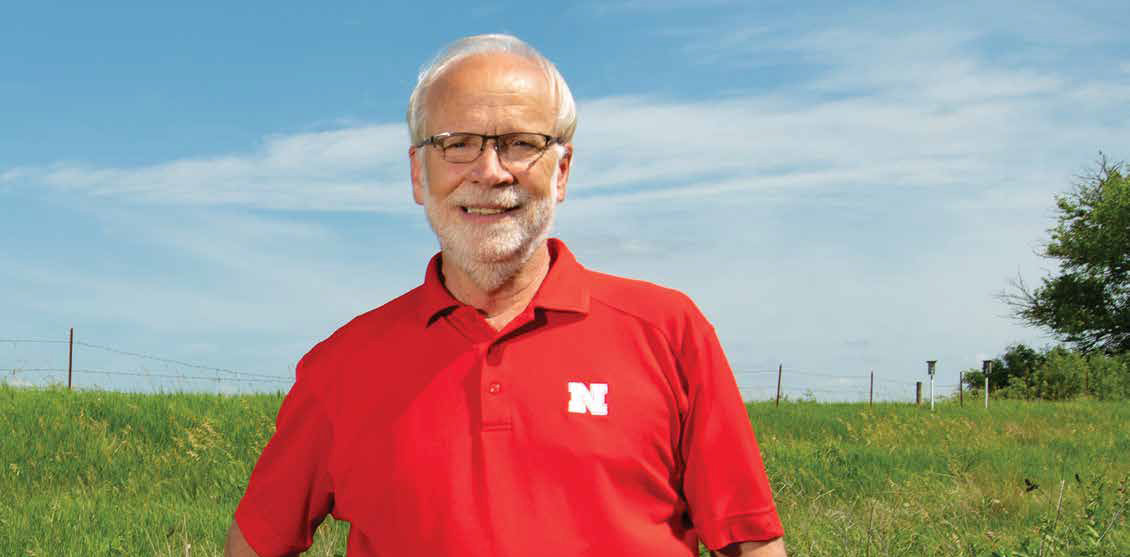
Grassland Ecology in the Nebraska Sandhills
Efficiency of Grazing Lands in a Cool Season Grass Pasture

With the world population set to reach almost 10 billion people by 2050, there is a great opportunity to produce more protein for the hungry world through proper management of grasslands. Many look to innovative farming practices to produce more food, but Walter Schacht, professor in Department of Agronomy and Horticulture at the University of Nebraska–Lincoln, said that there is another resource that is crucial to meeting future food demands — grasslands.
“Grasslands play a large role in food security. Managing the grasslands resource for efficient production purposes is crucial to the health and needs of consumers as well as the long-term productivity and sustainability of these rangelands,” Schacht said.
The most efficient way that grasslands can be managed for food production is by having ruminant animals, or cattle, graze the land. According to Schacht, beef production represents the largest segment of the agricultural industry in Nebraska. Beef cattle grazing is the principal means of converting grassland, which is largely undigestible by humans, to protein that humans can digest.
Schacht explained that Nebraska’s grasslands are a critical component of the beef industry. As cities and recreation grow and grassland acres are lost, more pressure is put on the remaining grasslands to be highly productive. Complete and efficient use of the remaining grazing lands, while preserving wildlife habitat and the long-term productivity of diverse forages, is vital.
According to Schacht, Nebraska’s advantage is the sheer number of acres of grassland and the opportunity to maintain the balance between forage production for grazing livestock and multiple other ecosystems services, such as biodiversity and wildlife.
Schacht’s research focus is on the grasslands of the Nebraska Sandhills, particularly as it relates to grazing and management of these grasslands. Specifically, he studies ecosystem responses to grazing management in the Nebraska Sandhills and other grasslands in the central Great Plains.
Rangeland Diversity in the Nebraska Sandhills
Schacht said nearly 40% of the surface area of the United States is grassland. The grassland resource as a whole must continue to be managed in sustainable ways both from an agricultural production aspect and a natural resource base. The Nebraska Sandhills region is grassland, and its resilience plays a large role in meeting food demands in the future, he said.
The Nebraska Sandhills is a semiarid region of mixed-grass prairie on grass-stabilized sand dune formations. In total, the Nebraska Sandhills consist of about 12.75 million acres, or approximately 19,300 square miles of rangeland. Over 90% is privately owned, according to Schacht. The region is home to the largest sand dune formations in the western hemisphere. From the uplands of the Nebraska Sandhills to the wetlands and subirrigated meadows, the region has a wide range of ecosystems.
Uplands in the Nebraska Sandhills are the rolling and vast grass-covered sand dunes, he said. Lakes and subirrigated meadows are common in the valleys. This variation in habitat results in a broad diversity of plant communities, grazing land types, and wildlife species.
Schacht said the 720+ plant species that grow in the Sandhills without cultivation provide for resilience to periodic harsh conditions (e.g., drought) and sustain forage plant production for grazing livestock. Grasses are classified as being a cool season or warm season species, which is based on their growth response to air temperature.
Grazing Management Plans
Grazing management plans are critical to the success of grassland areas, according to Schacht. Specifically, he said, grazing management plans enhance native grassland ecosystems, while sustaining wildlife and natural resources. Schacht works with students and ranchers in the Nebraska Sandhills to assist them in implementing the best practices for each operation.
“There is not one single recipe or best rotational grazing system that can work for everyone’s ranching operation — rather, each plan should be customized to fit the production environment and needs of the operation,” Schacht said.
However, Schacht typically uses five management components in identifying the best practices for grazing management plans when helping ranchers maintain healthy grazing land ecosystems for livestock and wildlife.
To determine a grazing management plan for ideal grazing, Schacht suggests that ranchers consider:
- Intensity of grazing: how many cattle are in a specific pasture
- Frequency of grazing: how often a pasture or grassland is grazed
- Timing of grazing: which season or part of a season is a pasture grazed
- Length of grazing period: how long a pasture is grazed (e.g., half-day or season long)
- Length of recovery period: how long a pasture is not grazed
Types of Grazing Management
Schacht said there are several grazing management methods that ranchers can use to better manage their grasslands for livestock production and wildlife purposes. The implementation of grazing methods allows ranchers to enhance the production and quality of grasslands to aid in production of livestock to feed the world.
Management Intensive Grazing
Management-intensive practices are characterized by rapid rotation of cattle through a relatively large number of pastures (eight or more) multiple times during the growing season, according to Schacht. These practices generally reduce selective grazing, resulting in relatively even use of pasture vegetation and high grazing efficiency. Optimizing the amount of forage harvested is the goal of short-duration, high-intensity grazing, often referred to as mob grazing, he said.
Season-long Continuous Stocking
In season-long continuous stocking, Schacht said ranchers manage the herd by keeping them in the same pasture throughout the grazing season, which is typically from mid-May to mid-October. Season-long continuous grazing with low to moderate stocking rates allows for greater forage selectivity by livestock, which increases the nutritional quality of forage consumed.
However, Schacht said that because of the selective grazing, livestock will graze more in areas near water, near the mineral supplements, in the shade or on north-facing slopes. This is low-management intensity, resulting in a loss of efficiency of grazing from a livestock production perspective.
Simple Rotational Grazing
Simple rotational grazing strategies involve moving livestock through a series of pastures (<8) a single time at scheduled intervals, commonly deferring grazing on one pasture until after the growing season, according to Schacht. Grazing periods are longer than they are with management-intensive grazing. Grazing efficiency is commonly greater with simple rotational grazing than with continuous grazing.
Schacht said the grazing methods are specifically tailored to sustained forage plant production and livestock production on grazing lands. Managing grazing lands in Nebraska is primarily focused on beef production.
“With a growing beef industry, I think the intensity of management of grazing lands is going to increase. The evenness and use of our grazing lands are going to increase as we need to produce more beef per acre because we will have fewer acres of grazing lands,” Schacht said.